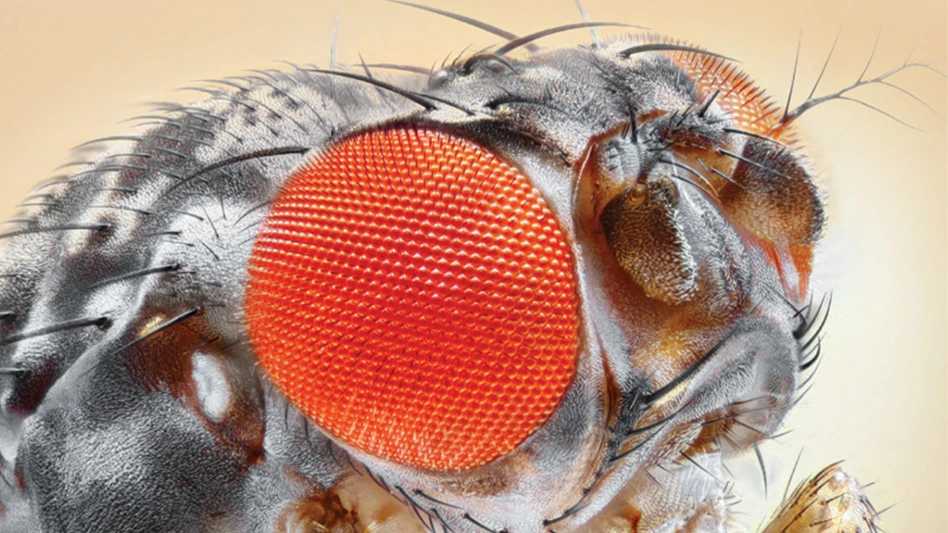
Moving to a house in the country, one accepts the fact that more insects, spiders and other pests are likely both in and around the house. As an entomologist, I welcomed this fact with open arms. I knew our new house had a moderate brown recluse spider (Loxosceles reclusa) infestation to begin with and I discovered a number of hidden locations with recluse spiders while remodeling numerous areas of the home.
I was surprised at the numbers of long-bodied cellar spiders (Pholcus phalangioides) found in the garage and porches and the fact this spider was found in many rooms inside (see Figure 1). Typically, interior web-building spiders involve comb-foot spiders in the genus Parasteatoda, and cellar spiders are found more in a garage or crawlspace.
Wolf spiders (several species) and jumping spiders (up to five species found so far) are the predominant spider species in the yard and seen by/on the house. Green lynx spiders (Peucetia viridans) are also common. Furrow orb weavers (Larinioides cornutus) are the predominant orb weaver species seen on the house itself. Other orb weavers seen on the property include the spiny orb weaver (Gasteracantha cancriformes) and the lichen orb weaver (Araneus bicentenarius). Six-spotted fishing spiders (Dolomedes triton) and dark fishing spiders (Dolomedes tenebrosus) were found in the pond and in the wooded areas on the property.
RECLUSE SPIDER UPDATE. In several previous PCT articles, I detailed the steps I have taken to (1) pest-proof my house through exclusion and improving moisture management and (2) treatment efforts to reduce recluse spider numbers in the house. The following reviews some of the treatment strategies employed to control recluse spiders at my home:

Figure 1: Cellar spiders are very common in the garage and porches of my house, and are often seen inside.
- Treatment of wall voids behind all light switches, electrical outlets and plumbing wall penetrations.
- Treatment of all cracks behind and under baseboards, and behind doors and window trim.
- Treatment under all bathtubs and voids, behind kitchen cabinets and bath vanities.
- Interior exclusion efforts: sealing around all door trim and holes around plumbing entering the walls; installing full-covering LED lights on all can lights.
- Application of a residual dust along and under insulation in the attic, into soffits in the attic and under attic flooring.
- Periodic application of spot treatments using an SC product to baseboards behind furniture and toilets.
- Drilling holes every 4 feet through exterior brick veneer and applying a residual dust behind the veneer using a compressed air duster.
- Placement of monitoring traps behind furniture and toilets as well in accessible attic areas to monitor recluse activity.
I did not implement all of these steps at one time, rather I spread them out over time to see what effect each might have on the numbers of recluse spiders I would see and trap in the monitoring traps.
Recluse spiders began activity in late April each year when outside temperatures reached a high in the 70s on average (see Figure 2). As the weather continued to warm, more spiders could be seen wandering on floors and being captured on traps. Activity ceased in late October.

Most of the recluse population was located within the attic spaces, and treatments applied there significantly decreased spider sightings. Numbers seen and trapped dropped from several dozen recluses in a week when I first began remodeling the house to around a dozen a week. Crack and crevice treatments in the rooms of the house and sealing off interior cracks further reduced the numbers of recluses wandering about.
Applications of spot treatments to baseboards behind furniture was the key to reducing sightings to zero for weeks at a time. Dead spiders would be found but live recluses were few and far between. Such treatments needed to be reapplied every one to two months to keep live recluse sightings minimized.
The treatment behind the brick veneer and in exterior cracks ended any sightings of recluse spiders on the outside of the house when I took the time to do night inspections.
WEB-BUILDING SPIDERS. Cellar spiders (Pholcus phalangioides) and house spiders (Parasteatoda sp.) were well-populated in my garage and the back porch. The porch was enclosed on three sides and thus was well protected from the rain and other elements. My house backs up to a hay field and pasture land, which provides no shortage of tiny spiderlings bombarding my house during warm months. Flying insects emanating from the field, the pond and wooded areas provide a constant supply of food for web-building spiders outside. The back porch provided an ideal testing ground to determine the effectiveness of various spider management techniques (see Figure 3).
To help protect against mosquitoes and other flying insects while enjoying the back porch, I installed a mosquito curtain across the open front. This curtain is not completely tight-fitting so some flying and crawling insects manage to find their way around the edges of the curtain. I was surprised, however, at the numbers of cellar and house spiders that would be found on the porch, finding enough prey to thrive.
Pest professionals often implement sweeping service on a home’s exterior using a cobweb duster. Spot treatments are typically then applied to corners and under soffits where web-building spiders are seen.
MY SPIDER THOUGHTS. The following is not based on any scientifically designed study, rather these results are observations of the levels of spider activity after control efforts much the way a customer might notice after pest control services.
- I have installed yellow LED bulbs in my exterior fixtures or otherwise keep outside lights turned off to help limit the numbers of flying insects attracted that feed spiders. Still, interior lighting seen through windows does attract enough insects to the home to support web-building spiders. This is especially true of my home’s back porch where I see significant web-building spider activity.
- When I used a cobweb duster to simply brush down spiders and their webs, spiders dropped to the porch floor and later quickly rebuilt webs. The overall numbers were not really reduced although the removal of all the old webbing made it seem as if some population reduction had occurred.
- If spot treatments were immediately applied after sweeping away webbing, some population reduction was observed, but spider numbers quickly rebounded to normal levels within a few weeks.
- When spot treatments were applied to locations with spider activity and then the webs were swept away, the results were much improved. It took a couple of months following this approach for new spider incursions from the exterior for activity to return to normal levels. Treating first contacts spiders directly, ultimately killing most of the spiders contacted even when they dropped to the ground during sweeping activities.
- Vacuuming spiders, their webs and egg sacs worked better than the cobweb duster in minimizing numbers of spiders on the porch for several weeks.
- Application of spot treatments whether before or after vacuuming kept spider numbers to a minimum longer than any of the other approaches used.
- Use of vacuums for web-building spider control around the exterior of a home is not feasible for a variety of reasons. Still, if large populations of black or brown widows is involved, vacuuming may be a prudent approach as it removes spiders and egg sacs.

WOLF SPIDERS. Interestingly, in my home, wolf spiders start being seen inside during the late fall as temperatures begin to drop outside. Then when outdoor temperatures warm in the spring, my home will experience a second round of wolf spider sightings for a few weeks. I find it unusual, however, that I don’t see wolf spiders inside during the rest of the spring and summer given how many wolf spiders can be found outside in the lawn around the house. It is only when the weather changes during fall and spring that wolf spiders are seen inside.
I made considerable efforts to pest proof my home, but as can be expected, no home can be completely pest proofed. I screened off the weep holes in the brick veneer and treated behind the brick veneer last fall. It will be interesting to see how much effect, if any, these efforts will have in the future in reducing wolf spiders indoors.
SUMMARY. Brown recluse spiders are inherently difficult to control, let alone eliminate, because by their very nature the females remain reclusive, hiding within hard-to-access voids and areas of the attic. The greater the initial recluse population, the more effort and time it will take to minimize recluse sightings to a desirable level. Monthly pest prevention services from spring through fall may be needed for the worst infestations. Complete elimination is unlikely with higher initial populations, especially in older homes or buildings.
Complete elimination of web-building spiders in or especially on a home or building is unlikely to occur. Structures are under siege daily from ballooning spiderlings during warm months so reinfestation is a constant threat. The best results in spider management involve direct contact treatment of spiders in their web before removal of spiders and their egg sacs via sweeping or vacuuming.
Get curated news on YOUR industry.
Enter your email to receive our newsletters.

Explore the May 2021 Issue
Check out more from this issue and find your next story to read.
Latest from Pest Control Technology
- Indiana PCO Wins Cicada Bobblehead
- Typhoon 3 Sprayer
- A&C Pest Management Wins Best of Long Island Award
- Certus Promotes Rezk to Chief Marketing Officer
- Forty-Seven Percent of PCOs Increased Mental Health Care Benefits, Poll Finds
- Samantha Malone on Growing Confidence, Building Relationships Through ELP
- Surge in Pest Populations Expected This Spring, NPMA Bug Barometer Finds
- CoverAll Pests Celebrates 10 Years in Business





